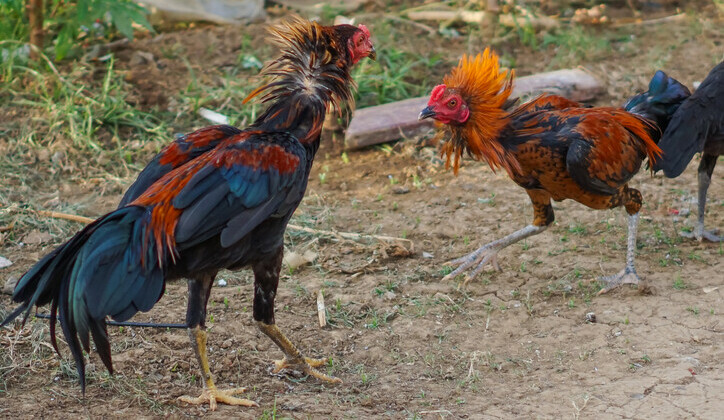
Looking at this chicken reminds me of the velociraptors in Jurassic Park. If you want a chicken that looks like a dinosaur, get a Malay.
Look at the size of those feet! And that beak looks like it could really take a chunk out of your arm. It’s a small wonder that this breed has seen a history including cockfighting, a cruel and brutal activity.
A Breed Heads Above The Rest
No description of the Malay is complete without remarking about its height. Although the Malay is not the heaviest of the breeds, it is the tallest.
The Malay chicken is a truly majestic sight with a regal bearing. They are easily the tallest breed of chicken, with some roosters reaching an impressive 36 inches in height! Their long, powerful legs contribute to this impressive stature, and their bodies are muscular and well-developed.
Color variations within the breed are diverse and eye-catching. Black, black-breasted red, red, wheaten, and white are all recognized colors, each with its own unique beauty.
The Malay comb is small and walnut-shaped, and the wattles are minimal or even absent. Their feathers are short and tightly packed, giving them a sleek appearance.
Tempestuous Temperament

To go along with their impressive size and strength, Malay chickens can be aggressive.
Talk about getting your hackles up! They do have a reputation for being bold and assertive, and they can be territorial with other poultry. They are also quite active and energetic birds, requiring ample space to roam and explore.
However, while not the most cuddly breed, Malay chickens can be friendly and curious towards humans, particularly if they are well-socialized from a young age. However, their strong personalities require a firm but gentle hand in training.
They are not a breed suitable for young children because if they are cornered, they will come out fighting rather than running away or cowering. Ouch!
They are also not particularly friendly to other breeds, especially when confined.
Production
Egg Production
While not prolific egg layers, Malay hens typically lay around 100-120 medium-sized brown eggs per year. They are not known for their broodiness, but they can make excellent mothers when they do go broody.
While a well-managed flock of Malay hens could produce the average, some hens might lay many fewer eggs per year, like around 20. Broodiness is a factor.
If you are looking for a lot of eggs from Malays, you will be disappointed. Look at the bright side. You might not need an egg basket.
Meat production:
The Malay chicken was originally developed for meat production; some find the meat coarse, while others appreciate its firm texture and abundant yield.
Roosters can reach up to 10 pounds, while hens typically weigh around 7 pounds.
Dual-purpose
While primarily valued for their meat production, Malay chickens can also be considered a dual-purpose breed due to their egg-laying capabilities.
This depends, of course, on your egg usage. The advantage of having a hen that doesn’t produce an abundance of eggs is that you won’t have to figure out what to do with them all.
On the other hand, if you want eggs every day or plan on trying to sell eggs, Malays are not the bird for you.
If you have ever had eggs coming out of your ears, you will appreciate the Malay’s stinginess when it comes to laying.

Other factors
Climate suitability
Malay chickens are relatively adaptable and can thrive in a variety of climates. However, they do best in warm, humid environments and may require additional care during cold winters.
Space requirements
Due to their size and activity level, Malay chickens need ample space to run and exercise. And although they are big, they can fly. They are not suitable for small coops or confinement. Ideally, they should have access to a spacious run where they can forage and explore.
Predators
While their size can deter some predators, Malay chickens are still vulnerable to attacks from foxes, coyotes, and other large animals. It is important to provide them with secure housing and predator-proof fencing.
Common health problems
Malay chickens are generally hardy birds and are not prone to any specific health problems. However, like all chickens, they can be susceptible to parasites and diseases common to poultry, such as coccidiosis and Marek’s disease.
Regular vaccinations and good hygiene practices are essential for keeping them healthy.
Rarity
While not considered rare, Malay chickens are not as common as some other breeds. You may need to contact a specialized breeder or hatchery to obtain them.
The Livestock Conservancy works to preserve heritage breeds like the Malay. Consider supporting their efforts!
Cost
The price of Malay chickens can vary depending on the quality of the bird and the breeder. Generally, you can expect to pay around $50-100 for chicks and $100-200 for adults.
A Unique Breed with a Rich History
Origins:
The Malay chicken, once widely found throughout Asia, is an ancient breed with a unique history. Its massive size, heavy bones, and fierce appearance set it apart from other breeds.
It is believed to have originated in Southeast Asia, where they were used for cockfighting for centuries.
Believed to descend from the great Kulm fowls of India, the Malay boasts a lineage dating back thousands of years, rivaling its Indian cousin, the Aseel.
The Journey West:
By the 1830s, European enthusiasm for this exotic breed led to its introduction in England, followed by Holland, Germany, and eventually America.
The Malay’s impressive size drew much attention, but its suitability for meat production remained a point of debate. Some found the meat coarse, while others appreciated its firm texture and abundant yield.
The Malay’s leanness, ideal for tropical climates, also made it a unique addition to poultry circles.
Today, they are primarily kept for exhibition and meat production, although they can also be found in some backyard flocks.
Unique characteristics
The Malay’s contributions extend far beyond mere aesthetics. Its strong vitality has made it invaluable for crossing and reviving other Asian breeds, from Games to Longtails. This unique breed boasts an array of distinctive features:
- Hoarse, short, roaring crow
- Small wattles and bare throat/breast
- Low, thick, strawberry-shaped comb
- Yellow, short, broad, hooked beak
- Snaky, cruel expression with pearl eyes and overhanging brows
- Red walnut comb, wattles, and earlobes
- Close-fitting, firm, narrow, glossy feathers with a lustrous sheen
- Large yellow legs with prominent scales
One of the most unique characteristics of the Malay chicken is their long, curved claws. These claws can be up to 3 inches long and are used for fighting and defense. Remember what I said about velociraptors? Yikes!
Overall
The Malay chicken is a fascinating and majestic breed. They are not for everyone, as they require a specific environment and care. However, for those who can provide them with the space and attention they need, Malay chickens can be a rewarding addition to any flock.
They serve as a reminder of the rich history and diversity of poultry breeds. Their unique characteristics and contributions to other breeds make them a valuable part of the poultry community.
Disclaimer
This blog post is intended for informational purposes only and does not promote purchasing or breeding any particular animal. It is important to do your own research before deciding to acquire pets.
Thanks for reading. I hope you found this breed as fascinating as I do.
Dave

Chickenmethod.com
